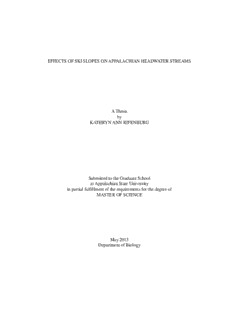
effects of ski slopes on appalachian headwater streams PDF
Preview effects of ski slopes on appalachian headwater streams
EFFECTS OF SKI SLOPES ON APPALACHIAN HEADWATER STREAMS A Thesis by KATHRYN ANN RIFENBURG Submitted to the Graduate School at Appalachian State University in partial fulfillment of the requirements for the degree of MASTER OF SCIENCE May 2013 Department of Biology EFFECTS OF SKI SLOPES ON APPALACHIAN HEADWATER STREAMS A Thesis by KATHRYN ANN RIFENBURG May 2013 APPROVED BY: Michael M. Gangloff Chairperson, Thesis Committee Christopher A. Badurek Member, Thesis Committee Michael D. Madritch Member, Thesis Committee Sue L. Edwards Chairperson, Department of Biology Edelma D. Huntley Dean, Research and Graduate Studies Copyright by Kathryn Ann Rifenburg 2013 All Rights Reserved Abstract EFFECTS OF SKI SLOPES ON APPALACHIAN HEADWATER STREAMS Kathryn A. Rifenburg B.S., Appalachian State University M.S., Appalachian State University Chairperson: Michael M. Gangloff Mountain ecosystems are increasingly stressed by human activities and global climate change. Ski resorts and other winter recreation areas (WRAs) are popular in temperate montane regions including the Southern Appalachian Mountains in southeastern North America. Large-scale land clearing and water extraction associated with WRAs may alter stream physicochemical attributes, biota and ultimately function. I examined impacts of four WRAs on physicochemical parameters and invertebrates in eight streams in the mountains of western North Carolina. I measured physicochemical parameters monthly, sampled invertebrates seasonally in 2011 and 2012 and measured fall and spring nutrient concentrations. Streams draining WRA-impacted catchments exhibited significantly elevated specific conductance and NO ¯ relative to control streams during spring sampling. 3 Invertebrate data revealed lower total densities at all but one of the impacted streams (F = 42.6, p = 0.03) and higher total diversity at control streams (F = 5.1, p = 0.03). EPT metrics varied considerably among streams and treatment. Total density and EPT richness were negatively correlated with several water chemistry and substrate parameters, whereas EPT H’ and total richness were positively correlated with open riparian land use. Water chemistry and iv habitat parameters exhibited more consistent responses to WRAs than did invertebrates. Counter-intuitive increases in some invertebrate metrics suggest that headwater stream responses to land use changes may be buffered by adjoining forested reaches or catchments and that responses to habitat and water chemistry alteration may be highly taxon-specific. The results of my study indicate that altered land use associated with WRAs may alter headwater stream communities and possibly ecosystem function through land use changes. v Acknowledgements This study was supported by the Appalachian State University (ASU) Office of Student Research. I would like to thank the following people for assisting with my research: my committee, Dr. Michael Gangloff, Dr. Christopher Badurek, and Dr. Michael Madritch, for guidance and critical input in the writing of this thesis. I would also like to thank the ASU Aquatic Conservation Research and Avian Behavioral and Evolutionary Ecology labs for assistance with fieldwork and suggestions for improving my project throughout the years. Thank you to Michael Perkins, Erin Abernethy, Alex Bentz, and Desiree Moffitt for the endless moral support, statistic help and making graduate school fun. Finally, thank you to Jacob Clark, Ben Forrest, Dave Hamilton, Byron Hamstead, Jordan Holcomb, Ryan Thoni and Jackie Wagner for invaluable assistance and hard work in the field. vi Table of Contents Abstract .............................................................................................................................. iv Acknowledgements ............................................................................................................ vi List of Tables ................................................................................................................... viii List of Figures .................................................................................................................... ix Foreword……………………………………………………………………………….….xi Introduction ..........................................................................................................................1 Methods................................................................................................................................6 Results ................................................................................................................................10 Discussion ..........................................................................................................................15 References ..........................................................................................................................19 Vita .....................................................................................................................................36 vii List of Tables Table 1. Percentage of riparian developed, forested and open land use at Appalachian Ski Mountain, Beech, Hawksnest and Sugar control and impacted streams………………….…26 Table 2. Mean water chemistry at Appalachian Ski Mountain, Beech, Hawksnest and Sugar control and impacted sites. SC = specific conductivity and RC = relative conductivity…....27 Table 3. Factor loading scores, total and cumulative percent variance explained by Principle Components with Eigenvalues >1.0, and contribution of habitat parameters to PCs. Habitat parameter abbreviations are as follows: DO (%) = % DO saturation, SC = specific conductivity, (corrected to 25°C), RC = relative conductivity, meansub = mean size of measured substrate particles………………………………………………………..……….32 viii List of Figures Figure 1. Control and impacted sites in Watauga and Avery County, North Carolina. Blue lines indicate streams, black lines delineate watersheds and blue shaded are populous areas………………………………………………………………………………………….25 Figure 2. Mean conductivity at Appalachian SM, Beech, Sugar and Hawksnest control (white) and impacted (black) streams. Sites with different letters above the bars indicate significant differences between control and impacted streams (ANOVA, p > 0.05)………..26 Figure 3. Fall NO3¯ concentrations at Appalachian SM, Beech, Sugar and Hawksnest control (white) and impacted (black) streams. Sites with different letters above the bars indicate significant differences between control and impacted streams (ANOVA, p > 0.05)…………………………………………………………………………………….…..28 Figure 4. Total invertebrate assemblage diversity (H’, A), density (#/m2, B), and richness (C) from streams at Appalachian SM, Beech, Sugar and Hawksnest. Sites with different letters above the bars indicate significant differences between control and impacted streams (ANOVA, p > 0.05)………………………………………………………………………….29 Figure 5. Mean Epheremoptera, Plecoptera and Trichoptera (EPT) diversity (H’, A), density (#/m2, B), and richness (C) at Appalachian SM, Beech, Sugar and Hawksnest control (white) and impacted (black) streams. Sites with different letters above the bars indicate significant differences between control and impacted streams (ANOVA, p > 0.05)……………………31 Figure 6. Specific conductivity positively correlated with developed land use in a 100 m riparian zone around sampling sites (r = 0.550, p = 0.015)…………………………………33 s ix Figure 7. PC (temperature, percent bedrock substrate and mean particle size) positively 3 correlated with open land use in a 100 m riparian zone around sampling sites (r = 0.444, p = s 0.30)…………………………………………………………………………….……………34 Figure 8. Total richness positively correlated with open land use in a 100 m riparian zone around sampling sites (r = 0.559, p = 0.004)………………………………………………..35 s x
Description: